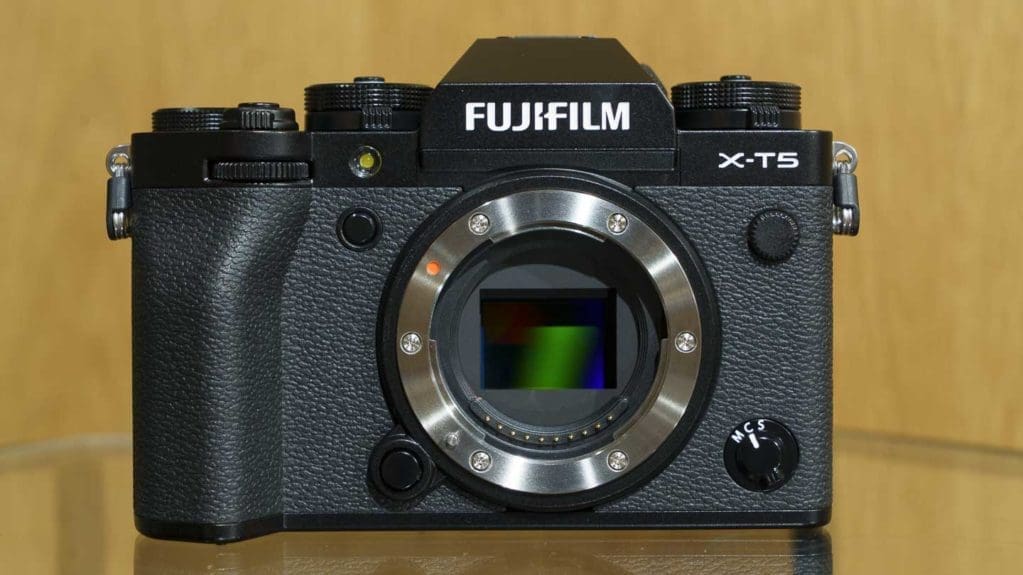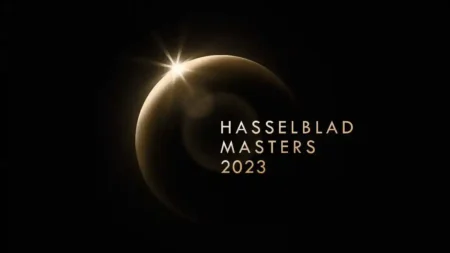The Fujifilm X-T series of APS-C format mirrorless cameras are aimed at enthusiast photographers. The introduction of the 26MP Fujifilm X-H2S and 40MP Fujifilm X-H2, which are aimed at professional content creators who want high-speed shooting, high-end video features or detail-rich images, means that Fujifilm has been able to focus its attention a bit more on what enthusiast photographers want from the latest X-T series camera. Consequently, the Fujifilm X-T5 reviewed here features the same 40MP X-Trans CMOS 5 HR sensor as the X-H2 but in a more compact body with traditional exposure controls and a rear screen that can tilt in 3 directions.
Our Verdict
The Fujifilm X-T5 has been eagerly anticipated by Fujifilm fans and it doesn’t disappoint. It makes a very healthy step up from the X-T4 in terms of resolution while keeping noise under control well. The focusing is also fast and effective with the Subject Detection system promising to make it easier than ever before to render the subject sharp. Add to this Fujifilm’s superb Film Simulation modes, a 3-way tilting screen and a more than decent viewfinder and it’s a pretty convincing argument for upgrading from the X-T4 or an earlier X-T series camera.
For
- Major step-up in resolution from the X-T4
- New subject detection system
- 3-way tilting screen
Against
- Crop applied to many of the video outputs
- Complex collection of continuous shooting options
What is the Fujifilm X-T5?
Specification
- Camera Type: Mirrorless
- Announced: 2nd November 2022
- Lens Mount: Fujifilm X
- Sensor: 40.2MP X-Transn5 BSI APS-C (23.5 x 15.6mm) Imaging Sensor
- Processing Engine: X-Processor 5
- Video: 6.2K (6240 x 3510) at up to 30p with 1.23x crop, DCI4K (4096 x 2160) at up to 60p with 1.14x crop, HD at 240p with 1.23x crop, 6.2K Apple ProRes externally in 10-bit at 4:2:2
- Sensitivity: ISO 125 to 12,800 (expandable to ISO 64 to 51,200)
- In-Body Image Stabilisation (IBIS): 5-axis giving up to 7 stops shutter speed compensation
- Max Shutter Speed: 1/180,000 with electronic shutter
- Continuous Shooting: 15fps with mechanical shutter, 20fps with electronic shutter (later with 1.29x crop)
- Viewfinder: 0.5-inch type 3.69-million-dot EVF with 0.8x magnification
- Rear Screen: 1.84 million-dot 3-way tilt LCD touchscreen
- Storage: 2x SD/SDHC/SDXV UHS-II
- Battery: NP-W235 Li-ion
- Dimensions (WxHxD): 129.5 x 91 x 63.8mm
- Weight: 557g with battery and memory card, 476g body only
Features
As in the X-H2, Fujifilm has teamed the Fujifilm X-T5’s 40.2 MP backside-illuminated X-Trans CMOS 5 HR sensor with its latest processing engine, the X-Processor 5. This enables a host of improvements in comparison with the Fujifilm X-T4, including AI-trained Subject Detection for aeroplanes, trains, cars, motorcycles animals and birds in addition to human face and eye detection.
There’s also 100% phase-detection autofocusing coverage with 3.33-million phase detection pixels and low light focusing that’s claimed to work at down to -7EV.
In addition, the 5-axis in-body image stabilisation (IBIS) system has been uprated and can now offer up to 7EV shutter speed compensation with compatible stabilised lenses.
Fujifilm’s Pixel Shift Multi-Shot technology has also been added to enable images to be captured with four times the normal resolution. This mode uses the IBIS system to move the image sensor precisely between shots taken at 20fps (frames per second) with a single press of the shutter release. Photographers can then composite the images into one 160MP image using Fujifilm’s Pixel Shift Combiner software.
Further good news is that the X-T5’s lowest native sensitivity setting has been reduced to ISO 125, down from ISO 160 with the X-T4. Meanwhile, the highest native setting is ISO 12,800 (the same as the 26MP X-T4). The X-T5’s ISO range can also be expanded up to ISO 25,600 – a stop lower than the X-T4 in recognition of the higher pixel count.
Like the X-T4, the Fujifilm X-T5 has a maximum continuous shooting rate of 20fps when the electronic shutter is in use, and as before it incurs a 1.29x crop. This rate can be maintained for 168 Jpegs, 72 compressed raw files, 41 lossless compressed raw files, 23 uncompressed raw files, 37 compressed raw and Jpeg files, 31 lossless compressed raw files and Jpegs or 23 uncompressed raw and Jpeg files. Alternatively, switching to use the mechanical shutter drops the maximum continuous shooting rate to 15fps (with no crop) and the rate can be maintained for 119 Jpegs, 39 compressed raw files, 22 lossless compressed raw files, 17 uncompressed raw files, 27 compressed raw and Jpeg files, 21 lossless compressed raw files and Jpegs or 19 uncompressed raw and Jpeg files.
If the need arises, shooting with the electronic shutter at 8.9fps or the mechanical shutter at 10fps extends the Jpeg burst depth to over 1000 images.
Fujifilm’s Film Simulation modes are widely respected for their colour reproduction and the X-T5 has all 19 of the Film Simulation modes that are currently available. These include: PROVIA/Standard, Velvia/Vivid, ASTIA/Soft, Classic Chrome, PRO Neg.Hi, PRO Neg.Std, Classic Neg., Nostalgic Neg., ETERNA/Cinema, ETERNA BLEACH BYPASS, ACROS, ACROS + Ye Filter, ACROS + R Filter, ACROS + G Filter, Black & White, Black & White + Ye Filter,, Black & White + R Filter, Black & White + G Filter, Sepia.
The X-T5’s Auto White Balance system also draws on Deep Learning technology to enhance its ability to decide the white balance automatically.
In addition, stills can be shot in raw, Jpeg or HEIF format. HEIF format is less widely supported than Jpeg but it means that images are captured in 10-bit rather than 8-bit yet they are up to 30% smaller than standard Jpegs.
Fujifilm X-T5 video features
While Fujifilm has focussed attention on the stills-shooting aspect of the X-T5, it is also a very capable video camera. It can record 6.2K video internally at up to 30P and with 4:2:2 10-bit colour. There’s also a 4K HQ mode, in which the X-T5 uses 6.2K over-sampling to generate higher-quality 4K movies.
Further good news is that F-Log2 is supported to deliver 13+ stops of dynamic range.
In addition, the Fujifilm X-T5 can record raw video to an Atomos device connected via HDMI. This video is recorded as 12-bit Apple ProRes RAW at up to 6.2K with frame rates up to 29.97fps. When combined with Blackmagic Design Video Assist 12Gs, the X-T5’s raw video output can be recorded as Blackmagic RAW at up to 6.2K and frame rates up to 29.97fps.
All of the X-T5’s 6.2K video, 4K HQ video and 4K video at frame rates over 30p is subject to some form of crop, but the most dramatic is a 1.23x and some just encounters a 1.14x crop.
Build and handling
Fujifilm has listened to feedback from its users to inform the design of the X-T5. Consequently, the vari-angle screen that’s on the X-T4 has gone and the 3-way tilting screen of the Fujifilm X-T3 has made a return. This has the advantage over the usual tilting screen of being useful for shooting in both landscape and portrait orientation, but unlike like a vari-angle screen, it can’t be flipped to face forwards for vlogging. I don’t think that last point will be an issue for most of the photographers who like the X-T series and many will welcome the 3-way tilting screen.
The X-T5’s 3-inch 1.84-million-dot screen provides a nice clear view and is responsive to touch. As usual with Fujifilm X-series cameras, the main menu can’t be navigated by tough but it’s possible to select items in the Quick menu with a tap.
There’s also a 0.5-inch type 3.69-million-dot electronic viewfinder (EVF) with 0.8x magnification in the centre of the top-plate, which contributes to the X-T5’s DSLR-like styling. This is the same viewfinder as is on the X-T4 and it is lower resolution than the 5.76-million-dot EVF in the X-H2, but it draws no complaints from me as it provides a natural view with plenty of detail.
With dimensions of 129.5 x 91 x 63.8mm, the Fujifilm X-T5 is smaller than the X-T4, in fact it’s closer to the X-T1 in size, but it still has a well-shaped grip that gives plenty of purchase. It also weighs 557g with the battery and a memory card, which means it’s 50g lighter than the camera it replaces. Nevertheless, the X-T5 has a magnesium alloy body and is weather-sealed.
On the control front, the X-T5 is very similar to the X-T4. There are three dials on the top plate to set the ISO, shutter speed and exposure compensation, while aperture can be set via an aperture ring on the lens or using a dial on the camera.
Underneath the sensitivity (ISO) dial on the left of the X-T5’s top-plate there’s a switch to set the drive mode and another switch under the shutter speed dial on the right allows the camera to be set to shoot stills or video. The exposure metering mode is set via the menu.
Despite the reduction in body size, the buttons are in the same place on the X-T5 as they are on the X-T4. Consequently, anyone upgrading will find themselves in familiar territory straight away.
Performance
As the Fujifilm X-T5 has the same sensor and processor as the Fujifilm X-H2, it’s no surprise to find that it produces very similar images. However, they are rather different cameras, each with their own appeal and with the X-T5 being primarily intended as a stills camera, albeit with video capability, and designed to appeal to ‘traditional’ photographers.
Fujifilm’s colour reproduction is well known and widely respected. This paired with the X-T5’s competent metering system ensures that Jpeg images generally look good straight from the camera. The raw files are also very good but give more scope for post-capture adjustment.
Fujifilm’s new auto white balance system is very capable. It doesn’t remove dominant visible colours and consequently, images look as you see the scene at the time of capture. I found no reason to switch away from it during the majority of my testing.
Fujifilm X-T5 autofocus performance
The Fujifilm X-T5’s autofocus system impressed me from the outset, getting most subjects sharp quickly. It even copes very well with subjects close to the new XF 30mm F2.8 R LM WR Macro lens’ nearest focusing point. I was expecting it and the lens to hunt, but on most occasions it got the subject sharp quickly and decisively.
The X-T5’s Face and Eye Detection system also proved effective at spotting and focusing on human eyes in the frame. I’ll have to wait until I have the X-T5 for longer to see how the rest of the subject detection system works, but it should be on par with that of the excellent Fujifilm X-H2, which has the same sensor and processing engine.
The X-T5’s Face and Eye Detection system also proves effective at spotting and focusing on human eyes in the frame, but it’s the Animal and Bird Subject Detection modes that have me particularly excited. Birds are prone to making quick movements and can be incredibly difficult to follow but switching the Subject Detection mode to Bird make life a whole lot easier. If the bird is facing away from the camera, it usually manages to to spot it in the frame and lets you know by putting a box around it as it tracks it around the scene. And if an eye becomes visible in the frame, the camera is quick to alert you to the fact and focus on it. I’m very impressed by how little of an eye needs to be visible for the camera to detect and focus on it.
The Bird Subject Detection system proves especially helpful when birds are in a tree with branches coming between the subject and the camera. Normally, it would require a very small autofocus point to pinpoint the bird and avoid focusing on a branch, but armed with the ability to detect birds the camera does the work for you. It even manages to keep the bird’s eye sharp when there’s a branch in the foreground, right in the way of your shot.
Fujifilm X-T5 image quality
Thanks to its 40MP sensor, the Fujifilm X-T5 is capable of producing images with bags of detail at the lower end of the sensitivity (ISO) range. This is maintained well throughout the standard range of ISO 125-12,800. What’s more, at 300ppi, the images measure around 65.5 x 43.5cm and they should make superb prints. If that’s not big enough, there’s Pixel Shift Multi Shot mode in which the camera can shoot 20 images for compositing into one 160MP image. That’s probably way more than most photographers need, but I’ll look at this feature in more detail at a later date.
Even on a a bright sunny day, shooting in December in the UK with the Fujifilm Fujinon XF 150-600mm F5.6-8 R LM OIS WR means pushing the sensitivity up to ISO 6400 if you want a shutter speed of 1/500sec. Nevertheless, the results from the X-T5 are very good. Subtle noise is apparent at normal viewing sizes, and there is less detail visible than you get at the lower ISO settings, particularly in the Jpegs, but the results are still very usable. Images shot at ISO 12,800 are also decent, but if there’s a lot of very fine detail this may be lost from the Jpegs and it’s well-worth shooting raw files. I’d aim to make ISO 6,400 the maximum setting I use, but I wouldn’t get too stressed if the conditions demanded ISO 12,800.
While the X-T5 is primarily aimed at photographers, it’s also capable of producing very attractive 4K video. The AF system keeps the subject sharp while the metering, white balance and colour reproduction systems perform as they do for stills.
Fujifilm X-T5 IBIS
When shooting with the Fujinon XF 50-140 mm f/2.8 R LM OIS WR at 140mm (equivalent to 210mm in full-frame terms), I was able to get around 60% of my handheld images sharp when using a shutter speed of 1/4sec. That indicates a compensation factor if around 6EV for me.
Fujifilm X-T5 sample images
Follow the link to browse and download full-resolution images from the Fujifilm X-T5
[FAG id=1398552]
Verdict
Over the last few months, I have been asked about the Fujifilm X-T5 more than any other camera. We all knew it was coming, but there’s been lots of speculation about the nature and resolution of its sensor and whether the manufacturer would make significant changes to the control arrangement.
While it has incorporated some great new technology, Fujifilm has gone back to the roots of the X-T series for the X-T5. It has the traditional exposure controls that many photographers love, plus a fast and effective focusing system backed by subject detection.
The switch from a 26MP sensor to a 40MP chip also means that the X-T5 can capture more detail and produce larger images than the X-T4. This doesn’t come at a major cost to noise control in low light and it’s likely to prove to be major selling point for the camera.
In addition, the autofocus system is excellent with the Subject Detection system proving to be a major bonus.



